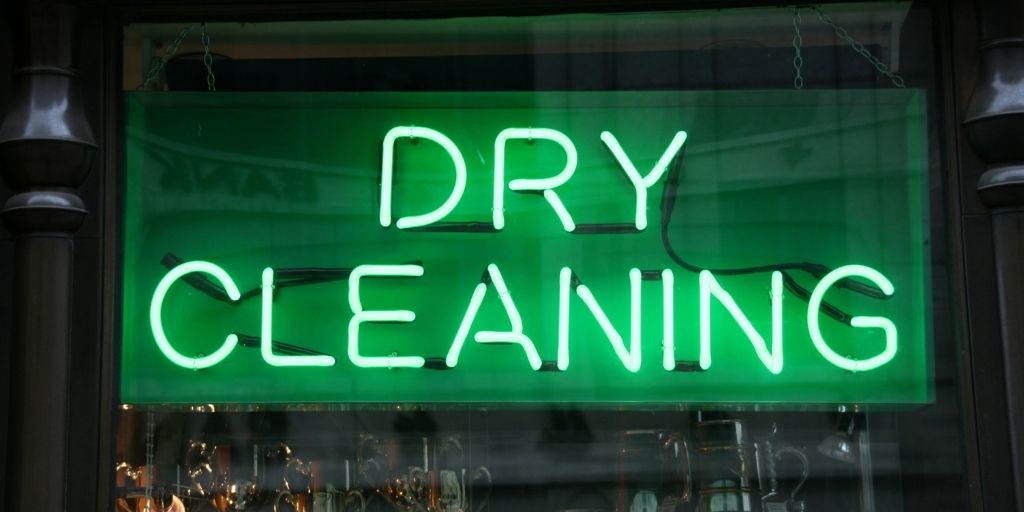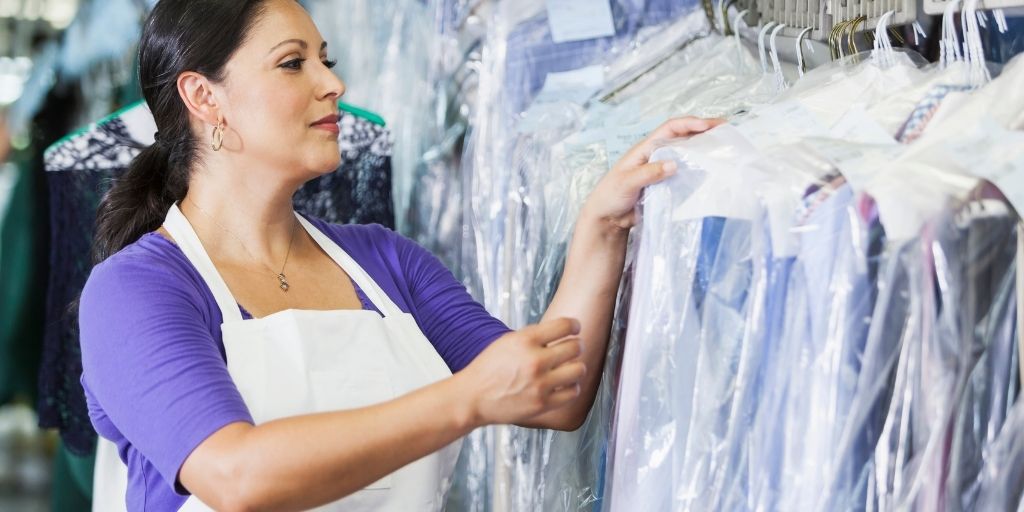We’ve all been there: clothes that we can’t clean, no matter how many times you wash them. You try to avoid the dry cleaner because of the cost, but then it’s either wear stained clothes or pay more for your peace of mind. When this happens, your local dry cleaner is there for you.
The dry cleaning method is an amazingly convenient way to have your clothes cleaned. It is a process that removes dirt and stains from clothes without the need for water. Also, it is the best way to keep your clothes looking good as new.
The article on how dry cleaning works will cover everything you need to know about what happens when you take your items of clothing for professional dry cleaning. To find out more about how this process works, read below!
Content Navigation
What Is Dry Cleaning?

The term “dry cleaning” is used to describe a process that cleans clothes without water. This method differs from its wet counterpart by immersing the garment in liquid solvent instead of water. Hence, the reason why it is referred to as “dry.” Furthermore, it’s also environmentally friendly, using less water than traditional methods like washing or hand-washing your clothing.
The process of dry cleaning will help remove oil, grease, grime and dirt. You can also use it to get rid of wine stains and other water-based stains. Moreover, garments made of taffeta, silk, velvet, or wool should be dry-cleaned by professionals unless the care label says otherwise. Also, it would be best to dry clean suede and leather garments to keep their condition at its best. This method uses low temperatures, so there is no need for concern when washing delicate fabrics like lace and voile. Therefore, it maintains the favourable condition of the material since it prevents stretching or shrinking, and it is best for fabrics that cannot withstand regular home wet cleaning.
How Does Dry Cleaning Work?

Professional dry cleaners use dry cleaning chemicals like tetrachloroethylene (perchloroethylene), also known as “perc” in the dry cleaning industry, evaporating quickly, unlike other substances used in the washing machine to clean soiled items of clothing.
Dry cleaners use big, high-tech machines to make your item of clothing cleaner. Suppose you’re wondering why dry cleaning machines don’t require water. In that case, it’s because they use a commercial cleaner that evaporates much faster than usual water. The solvent is continuously circulated throughout the entire process to remove impurities to be cleaner and fresher garments. Then the solvent is distilled and purified so it can be used again.
The Dry Cleaning Process

Ever wondered how dry cleaning works? The dry cleaning process begins when you drop off your pieces of clothing at the dry cleaners. The operations maintain a particular pattern that you will find in just about any dry-cleaning business. There are many steps to each garment being cleaned, and here’s how it works:
Tagging
Clothes are identified before being cleaned, and the process varies from dry cleaner to dry cleaner. It involves counting and describing each garment, then sticking a small, coloured tag on each item with a safety pin or staple. Others apply an iron-on strip to assign a barcode for regular customers permanently. Similar soiled garments will be cleaned together, and tagging guarantees that your clothes are returned to you after they’ve been cleaned.
Pre-treatment
Before the machine-washing process, the cleaner checks for and treats stains on clothes. It would be helpful if you informed the cleaners on what caused the stain to get the best results in removing it. They may also choose to remove or cover delicate buttons during this stage of cleaning.
Dry cleaning
The garments do not stay dry during the process of “dry” cleaning. They are cleaned by soaking in a water-free solvent. Though there are different brands and versions of laundry machines, they all have the same function.
The clothes are placed in the perforated basket. They are constantly being washed by a constant flow of clean solvent that is sprayed onto them. In addition, the solution gently pounds and cleanses the clothes against baffles within the washing tank as well. The dirty solvent is continuously pumped through a filter system before re-circulating free of dirt trapped therein.
Post spotting
The dry cleaning process effectively removes oil-based stains, but other types of stains can be resistant.
For them to maintain the highest quality of cleaning, all garments are post-spot checked. Spot removal is one part of a series of quality control that ensures clothes look their best. Post-spot treatment uses professional equipment and chemicals to remove stubborn stains on the clothing.
Finishing
The final step of dry-cleaning operations includes:
- Steaming or pressing out wrinkles.
- Reattaching buttons.
- Making repairs to restore the garment into pristine condition.
The plastic bags provided to you are only there for your convenience. Plastic bags are supplied to help you bring your clothes home without stains. It is advised that you take them off as soon as possible, or they could cause damage to the clothes because of moisture.
Cost of Dry-Cleaning in Australia

The cost of dry-cleaning in Australia varies per clothing item, fabric, and location of the dry cleaners. Some may offer discounts depending on the volume or the number of garments to be cleaned.
Clothing Dry Cleaning Cost
- Business Trousers – Men / Women – From $15
- Business Jackets – Men / Women – From $15
- Coats / Parka – From $18
- Skirts – From $14.30
- Business Suits – From $30.20
- Business Shirts – From $5.75
- Blouses – From $10.60
- Dresses – From $9.60
- Long Evening Dress – From $35
- Overcoats – From $24.60
Accessories
- Scarf – $8.60
- Ties – $8.60
- Knits – $13.50
Bedding & Household Items Dry cleaning Cost
- Doonas – From $39
- Blankets – From $20.30
- Bedspreads – From $23.20
- Underlay – From $18
- Table Clothes – From $13.70
- Curtains – From $16.80 per drop
Learn More: Cost of Dry Cleaning in Australia 2021
Factors that can affect the cost of dry cleaning
Now that you have a good idea of what dry cleaning involves, it’s also essential to know how different factors can change the pricing when you visit a dry cleaner.
Overhead expense
One of the main drivers of how much you pay for dry-cleaning is the cost to operate a business. It includes solutions, rent and licenses, wages to employees and more. The operating costs play an essential part in what consumers end up paying.
Type of Chemicals Used
Years ago, dry cleaners relied on dangerous chemicals and solvents. While many still do, some are now switching to environmentally friendly products to help the environment or because the government mandates it.
It is more expensive to use organic solvents or eco-friendly dry cleaning products. Still, it may also be worth the cost so you can protect both your clothes and the environment.
Type of Service
Some dry cleaners offer a premium or express service. The express service is perfect for those in a rush. It’s great for last-minute tuxedo jobs or orders that include special instructions.
In most cases, you can have your garments ready in a day. However, convenience comes with a higher price tag. The express services can cost up to three times the standard rate.
Dry cleaning offers something for everyone. Along with the standard dry-cleaning process that most customers are familiar with, one can also choose from a variety of premium services, such as multi-stage cleaning process and hand finishing, which includes minor repairs like rips or hem adjustments and even insurance for customers’ most important garments.
While it may seem worthwhile to have your wedding dress, tuxedo, or designer clothes professionally cleaned, these premium services come with a hefty price tag.
Material and Type of Garments
Fabrics are not the same. Some garments require less time and care, while others, such as delicate dresses, take more time and effort to ensure they don’t get damaged in processing. Other factors may also come into play, like how much space your duvet takes in the dry cleaner’s machines. Thus, it’s important to consider these factors when taking it to the dry cleaner as it may cost higher than usual.
Pros & Cons of Dry Cleaning Your Garment

Pros
Convenient
The best thing about using a dry cleaner is that they do the washing for you. You don’t have to spend hours in the laundry room by yourself. You can rely on them for pickup as well as delivery at your doorstep when finished.
Gentle cleaning on fabrics
Unlike traditional washing methods, dry cleaning is gentle on clothes and more environment-friendly. That’s because the solvents used are less abrasive for clothing than detergent soap or bleach. In conventional washing, your clothes will be exposed to harsh detergents as well as heat from the dryer, which tends to worn out clothes over time.
Great Expertise
Dry cleaning services take excellent care of the clothes they are tasked with cleaning, preserving their cleanliness and quality. They offer a thorough stain removal without compromising the condition of your clothes. They underwent training to be able to use machines with cutting-edge technologies to remove stains from different types of fabrics.
Meticulous Care
Professional dry-cleaning services can handle even the most stubborn stains. They also ensure that the clothes are looked over for any imperfections. The dry-cleaning process of clothes leaves them fresh and wrinkle-free, ensuring that you can wear the garments without concern.
Preserves the condition of the fabric
Dry cleaning strips dirt, stains and grime from clothes which will then look cleaner than if you do a regular machine wash. The fabric of the clothes tends to last longer and stays like new when dry cleaned; thus, it is the best way to extend the life of your clothes.
Water-free
When washing clothes in a machine, the laundry requires loads of water, which can cause the fabric colour to fade or shrink. Dry cleaning ensures that this will not happen, and there is little risk of the clothing items becoming altered in size.
Cons
Expensive
Dry cleaning is a more expensive process than washing clothes at home. Still, it is worth the investment as it preserves the quality of your clothing for years. Paying for professional dry-cleaning to remove stubborn stains is much less expensive than buying a new garment, especially a tuxedo or coat.
Solvents
One downside is the chemicals used may be hazardous. However, with increasing environmental awareness, companies rest assured that they will meet regulations and are not harming customers through safe alternatives like eco-friendly dry cleaning solvents.
Not an all-around stain removal solution
Dry cleaning is not always the solution for every stain or dirt, and neither can several other cleaning methods. However, it has the ability to remove most stains compared to other methods. Clients should ask dry cleaners about the type of stains they want to get rid of and let them know in advance. It will better understand what solvents and techniques are needed to best address the stains.-
Dry Cleaning FAQ’s
What agents are used in dry cleaning?
Cleaners use solvents such as tetrachloroethylene (perchloroethylene), also known as perc, evaporating more quickly than other substances used to clean clothes in a washing machine.
Is dry cleaning better than washing?
Cleaning methods for clothes vary between laundering and dry cleaning. Conventional laundering uses water and detergents, whereas dry cleaning utilizes a chemical solvent such as perchloroethylene.
Cleaning with water and detergent soap is the most common method of traditional washing. It can be done through hand washing or using a washing machine and dryer.
Dry cleaning does not use water and instead relies on solvents such as perc. It also preserves the appearance of your garments since it doesn’t shrink sensitive fabrics and maintains colour and texture better than washing does.
However, not all fabrics can be dry cleaned or washed; therefore, you must identify which cleaning procedure is best according to the care instructions on the label. Following the care instructions would be beneficial to your clothes as it prevents them from getting damaged.
What fabrics should not be dry cleaned?
Garments made of cotton doesn’t require dry-cleaning since most cotton clothing are preshrunk; thus, they can be dried in a machine.
Synthetic fabrics like nylon, polyester, spandex and acetate are less likely to shrink when washed in warm water. However, please put it in gentle spin or low temperature. These materials may wrinkle during the drying process and produce static electricity in the dryer. Thus, it is recommended that you use dryer sheets or hang them out to dry instead.
Does dry cleaning remove body odour from clothes?
Dry cleaning doesn’t do much to eliminate perspiration odour, so it may be better to avoid dry cleaning if a garment has this issue.
However, there is a technique called green cleaning or ozone cleaning, which uses pressurized liquid carbon dioxide instead of perc. It is much more successful in removing solid odours, such as tobacco smoke and sweat.
How do you prepare clothes for dry cleaning?
- Check the instructions before taking your piece of clothing to a professional dry cleaner. Some garments are not safe to dry clean, so be sure to refer to the instructions before proceeding with a wash or dry-cleaning machine.
- Assessment checks for any worn or weak areas should be pointed out so the garment does not get damaged upon return. Some cleaners offer alteration services which may also help with this problem, such as loose buttons and zippers on pants.
- Make sure to check dirty areas for stains and odours. Mark the location of any stains with paper or masking tape to be easy to locate later by the cleaner. You may also write the details on what caused the stain so the cleaner can adequately treat the area.
- Some things we carry around in our pockets end up being washed when we have clothes dry cleaned. These items can include chewing gum, pens, lighters and lipsticks. All laundromat workers try to check for these objects before washing the clothes. Still, it would be better if people take the time to look through their pockets beforehand.
Final Thoughts
I hope this blog post helped clear up some of the misconceptions you might have had about dry cleaning. Dry cleaning is indeed an excellent option for those who want to keep their clothes clean and fresh and looking good as new. Though this process could be done at home, it is still best to take your clothes to a professional dry cleaner.
However, you need to be aware of the disadvantages of dry-cleaning before deciding whether or not it’s right for you. While there are a few downsides, it’s important to remember that these benefits outweigh them for many people and make this service worth paying for.
If you have any other questions, we’re always here to answer them! Feel free to contact us at 08 9381 6688 or drop by Ad Astra, and we’ll be happy to answer all of your questions and provide a free quote on how much our services will cost.


